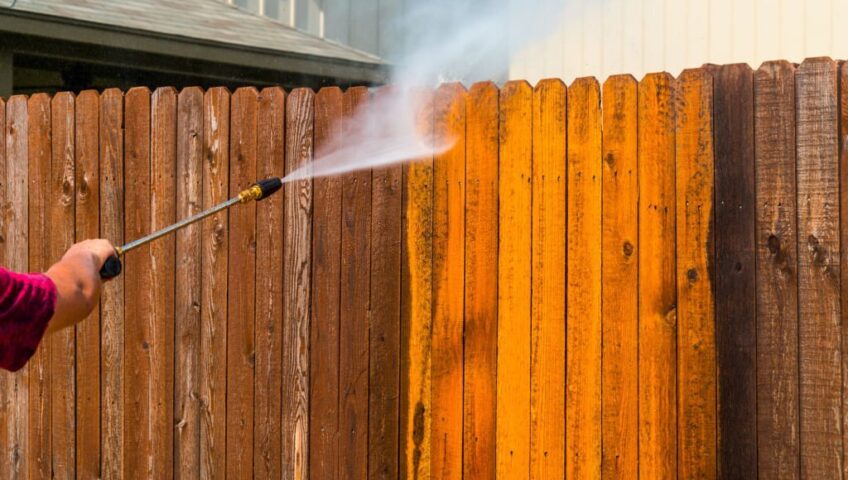
How to Pressure Wash a Fence
Fence cleaning is sometimes overlooked, but in actuality, a dirty fence speaks volumes about the overall state of the house and can really reveal years of neglect. As springtime approaches and more community members and local residents will be outside enjoying the gentle breeze, make your fence stand out by learning how to power wash a fence. Fences may harbor years’ worth of filth and germs. If this damage is allowed to build up, it may cost far more to rebuild the entire fence than it would use a straightforward fence cleaning solution. Read along to find out how you can pressure wash your fence with ease to boost your curb appeal this spring.
Preparation
Before you begin the actual power washing process, you should make sure that you have the proper preparation in place for the best results.
Preparation includes the following:
- Remove any abrasive particles from around and close to the fence.
- Ensure that your workspace is clear of clutter so that you won’t trip or stumble over anything.
- Keep doors and openings closed to prevent damage to your home’s inside.
- Use a sheet to cover surrounding objects such as trees, power outlets, lighting, patio chairs, and any other object.
- Place your pressure washer in a secure location.
Safety tips for homeowners
There are also some safety tips you should follow before pressure washing. The number one rule is to get acquainted with your tool so that you know how to turn it on and off at the right moment–especially if you’re a first-timer.
Some other safety tips include:
- When pressure washing, dress appropriately, and always use eye protection to safeguard against eye injuries from particles.
- Because the detergent includes chemicals that might harm your skin, handle pressure washer detergent cautiously and adhere to assembly instructions.
- After turning off your pressure washer, squeeze the tip trigger to relieve any leftover pressure before unplugging your nozzle.
- Always lay the pressure washer on a flat surface.
Scrub, scrub, scrub
There are three types of scrubbing solutions that you can use: your go-to chemical fence cleaning solution, a more natural homemade detergent with vinegar and baking soda, and a mechanical solution using sandpaper.
Chemical solution:
There are many concentrated soaps made for fence pressure washing that come at an affordable price. They are great for clearing out any mold or fungus that may have grown, bird droppings, and any dirt stains.
Natural solution:
You’ll need baking soda and vinegar for this. Baking soda works well as an abrasive substance, while vinegar has a moderately acidic nature. Although this approach will need a little more scrubbing, it is a fantastic substitute for harsh chemicals.
Mechanical solution:
You can also use sandpaper or a sanding machine instead of scrubbing if you have a lot of dirt buildup on your fence. This is also beneficial if you plan on painting your fence afterward.
Pressure Washing Tool Tips
Making sure you are using your pressure washer correctly and using a soft detergent product is important because wood is very delicate. Mistakes can be made quickly because pressure washers work at a high-speed rate. Here are the proper tools you should be using.
Type of pressure washer
A minor project, such as cleaning your car or a tiny picket fence, is best handled with an electric pressure washer. While having a larger power and giving you more freedom to roam around because they don’t need an outlet, gas pressure washers are excellent for cleaning wood fences. Gas pressure washers will be your greatest option because they are portable and light.
PSI (pounds per square inch)
For softer woods you should use a PSI between 500 to 800. If you have stronger wood you can use 1200 to 1500. The average homeowner ends up using around 1800 but even then, they are subtle with their use. Spray the little area on the corner of your fence with various PSI levels to see which one produces the greatest results while preserving the structural integrity of your fence. This will help you determine how much pressure your wood fence can withstand.
Nozzle
The nozzle that you put on your pressure washer also matters. We recommend a 25° tip and nothing less so that your fence gets thoroughly cleaned without any damage that comes with a larger degree tip.
Sweet satisfaction: Pressure washing!
If you are utilizing an average PSI rate of 1800, it will take you between two and three hours to clean a 500-square-foot fence. To prevent damaging the wood, be careful to use a lower psi. The best technique to use a pressure washer to clean a fence is to simply begin at one end and work your way through it section by section. In order to apply the detergent from bottom to top, your pressure washer’s detergent tank has to be switched on. While the detergent has to sit for 5 to 10 minutes, make sure to keep the area moist by applying water.
Planning to stain— pressure wash first!
Homeowners who are performing a deep clean of their fence also have plans to either paint or stain the fence. Mold and fungus-collecting microorganisms are removed by pressure washing. In order to prevent debris or deformations from soaking into the stain, you should always pressure wash your fence before staining.
Conclusion
Now that you have your beautiful picket fence looking shiny and brand new again, make sure that you protect it for the future. Use durable outdoor stains to prevent having to clean the surface once again. Doing so will allow you to only have to touch up the stain every once in a while. But make sure to wait a few days for your fence to dry completely. You may also repair damaged boards if necessary. We hoped this helped!

Write a Comment